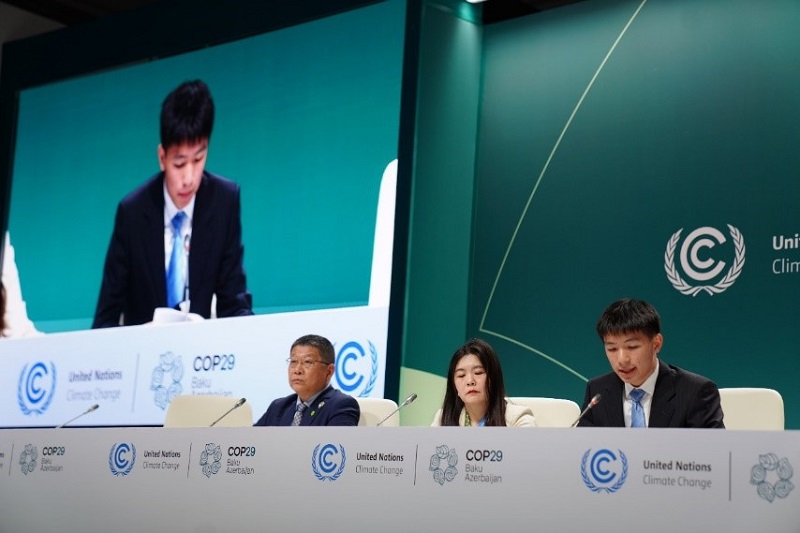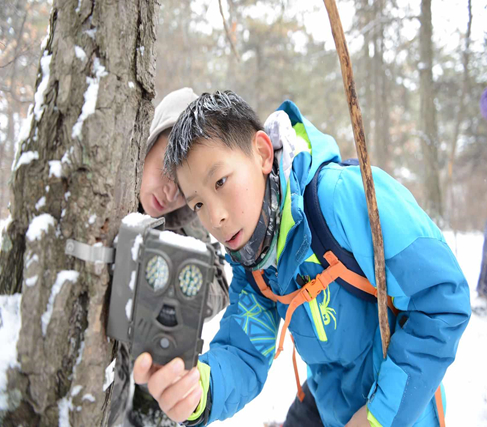Gao Shiqing, a 10th-grade student at Keystone Academy in Beijing, is a youth environmental ambassador for the All-China Environment Federation and a volunteer for the Chinese Felid Conservation Alliance (CFCA). From November 11-22, 2024, the 29th session of the Conference of the Parties to the United Nations Framework Convention on Climate Change (COP29) was held in Azerbaijan. As the only minor NGO observer from China attending the conference, Gao delivered a speech titled Me, Beijing, and Climate Action at a side event called China’s Solutions to Promote Public Climate Action.

A snapshot of Gao during his speech at the side event China’s Solutions to Promote Public Climate Action.
An Interest with Wild Animals Is Born.
Gao’s story with wild animals began with the North China Leopard, commonly known as the leopard. Few people know that the original habitat of this type of leopard was the mountainous region to the west and north of Beijing. Around 2005, the North China Leopard vanished due to the destruction of its habitat, and Beijing lost this iconic native animal. Then in 2017, CFCA began assessing biodiversity in north China mountains to evaluate the potential of restoring the leopard population in Beijing. The idea of “restoring” here does not mean transporting leopards directly into Beijing’s mountains by air, but rather assessing the area’s food chain, ensuring the continuity of ecological corridors in the Taihang Mountain, and eliminating human hunting to allow the species to return to its original habitat in Beijing naturally. In 2018, nine-year-old Gao Shiqing started volunteering with this project and has been involved in the process of finding the leopard, studying its journey to its habitat, and bringing it home. Now after six years what is the status of the North China Leopard, has it returned to Beijing?
China Today(CT): Did you find the leopard and can you tell us about the process of looking for it?
Gao Shiqing: First, we needed to find out where the nearest leopard population was to Beijing. In 2016, a stable group of about 40 leopards was recorded in Mafang Township, Heshun County of north China’s Shanxi Province, about 400 kilometers from Beijing. It was the closest recorded wild North China Leopard population to Beijing at the time. In 2020, Wang Yiqing and I recorded a North China Leopard living in Tuoliang National Nature Reserve, north China’s Hebei Province, about 300 kilometers from Beijing. At that time, it was the closest known leopard to Beijing. This news was shared at COP15, where I was dubbed China’s “Young Leopard Seeker.” Then in 2023, a North China Leopard was spotted in Chengnanzhuang Town, Baoding City of Hebei Province, about 200 kilometers from Beijing.
From 400 kilometers to 300 kilometers and then to 200 kilometers, it felt as if we could hear the footsteps of the North China Leopard returning to Beijing. Unfortunately, leopards still have not been spotted in the mountainous region surrounding Beijing. In 2024, I trekked through the Taihang Mountain and Yanshan Mountain ranges around Beijing but found no trace of any leopard.

Gao is searching for the North China Leopard in the mountains around Beijing.
CT: Apart from looking for the North China Leopard, have you also assessed whether or not the Taihang Mountain and Beijing’s forests are currently suitable for leopards with a complete food chain?
Gao: Yes, our research involves setting up infrared cameras in the mountains, collecting footage at regular intervals, and randomly capturing images of wildlife to calculate their activity frequency. I selected two observation sites: one near the Baihe Grand Canyon in Yanqing (P1) and the other in the mountainous area of Changshaoying Township in Huairou (P2). One is located near high mountains and rivers with a diverse vertical mountain ecosystem, while the other is nestled in a forest area containing a mix of conifers and broad-leaf trees, presenting a horizontally varied ecosystem. Together, these two points have provided complementary evidence that it could support a leopard population.
CT: What have you found?
Gao: P1 is the original habitat of the leopard cat. We have discovered its droppings scattered around the surrounding hills, showing that there is a thriving population. Through pattern identification in infrared camera images, we recorded around 20 leopard cats living in 1,000 square meters. The living conditions for the leopard cat population have been exceptionally great in Beijing’s northern mountains, and they have been frequently captured on camera in recent years. However, finding even one leopard cat was rare a decade ago. The number of other animals living on the small hill at P1 is also large, showing a strong biodiversity.
The P2 observation site is the only place on the outskirts of Beijing that can truly be called a primeval forest. This forest has a mixture of coniferous and broadleaf plants, unlike the current monoculture plantations commonly seen in other mountainous areas. It features large areas of oak trees. Oak leaves are not waxy, enabling them to decompose quickly, and the trees produce acorns during the fall, which serve as the ideal food for many animals living in the north China forests.
At P2, we recorded many mid-sized wild animals. The increase in the number of these animals in Beijing’s forests is encouraging. Badgers usually weigh around 10 kilograms, roe deer about 30 kilograms, gorals 50 kilograms, and adult wild boars often exceed 100 kilograms, all of which serve as an ample food source for North China Leopards.
At P2, we also discovered the red fox for the first time. This mid-sized carnivore has not been spotted in Beijing for over two decades. Three years ago, it was recorded on Lingshan Mountain in western Beijing. Now, we have also discovered it in the northern mountains of Huairou, likely the first time for this area. When will large carnivores return to Beijing’s forests? This question has been discussed for years, yet the return of North China Leopards, wolves, and jackals seems like a distant prospect. But then unexpectedly, the red fox quietly returned. It’s still uncertain whether or not it is a remnant of Beijing’s original red fox population or if it migrated from nearby Hebei Province.
During the past six years, my feeling is that the food chain for the North China Leopard in Beijing’s mountainous areas is gradually increasing. However, the numbers and continuity still need further observation.
CT: What is the present status of the North China Leopard?
Gao: Well, we don’t know when it will return. As nature works in mysterious ways, it might return at a time we least expect. All we can do is maintain low-carbon practices, restore ecosystems, pave the way for its return, and wait patiently.
CT: What’s your feelings about attending the COP29?
Gao: Whether or not the North China Leopard returns to Beijing is not what truly matters. What matters most is our action to protect our ecosystem. With the intricate web of life, nature provides us with sound mechanisms to tackle the challenges we face. Ecosystems with rich biodiversity are our invaluable allies in mitigating and adapting to climate change. By protecting and restoring these ecological systems, we can safeguard various kinds of species and enhance nature’s potential for carbon sequestration, thus strengthening our planet’s resilience. Our action plan is to promote these synergies, support biodiversity conservation, and mitigate the impacts brought by climate change through the power of nature.
Facing climate change, displaced animals, and endangered species, we must start acting today!
CT: What is your feeling after hearing the speeches from many countries’ representatives at COP29?
Gao: This conference brought together 50,000 to 60,000 people from various organizations and groups worldwide. It struck me that each person in this large crowd of people is like a seed. After the conference, they will return to their countries, take root, and grow, becoming the most passionate advocates for ecological protection and low-carbon and green development. Each year, more people will join us, influencing even more people until this issue will become a consensus for all humanity.